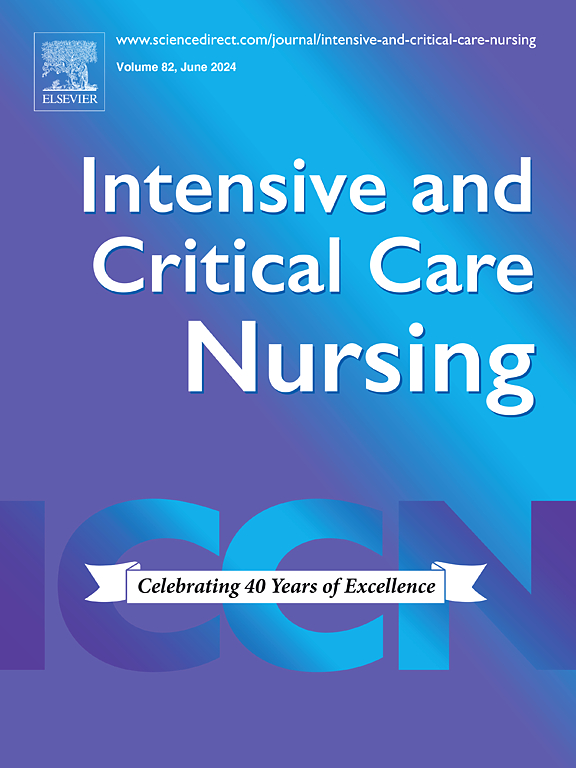Feasibility of implementing a communication board to improve communication interactions of mechanically ventilated patients in intensive care units at one Sri Lankan hospital − A pilot randomised controlled trial
IF 4.9
2区 医学
Q1 NURSING
引用次数: 0
Abstract
Objective
To evaluate the feasibility of implementing a communication board in intensive care units in terms of participant recruitment and retention, intervention fidelity, and ability to collect patient outcome data.
Design
A prospective, two-arm, unblinded, pilot randomised controlled trial.
Research methodology
Adult, conscious, mechanically ventilated intensive care patients were recruited between August and November 2023. All participants received routine communication practices; the intervention group also received the communication board. Prior to the study, all nurses were trained on using the communication board. Patient or proxy consent was obtained. Data were collected from patients, nurses, patients’ medical records, and screening, tracking, intervention fidelity, and contamination logs.
Main outcome measures
The primary outcome data was feasibility of participant recruitment, retention, and intervention fidelity, which was recorded daily until seven days of follow-up or pre-defined trial endpoints. Secondary patient outcomes (anxiety, satisfaction, ease of communication) were assessed at recruitment and approximately 24 h after recruitment or soon after extubation, whichever occurred first.
Setting
Two intensive care units in one Sri Lankan tertiary care hospital.
Results
Of the 123 patients, 60 (75.0%) were recruited and randomised (30 control; 30 intervention). All intervention group patients received the communication board (100% intervention fidelity), and 58 (96.7%) completed the follow-up. On recruitment, 12.5% of secondary patient outcome data was missing, and 9.9% on follow-up, predominantly associated with the 10-item ease of communication scale.
Conclusions
Conducting a larger, definitive communication board trial is feasible but collecting secondary patient outcome data, especially ease of communication was challenging. Study procedures need to be refined prior to a larger trial.
Implications for clinical practice
The use of communication boards in intensive care units may improve patient-centred care for ventilated patients but requires further, high quality effectiveness trials.
在斯里兰卡一家医院的重症监护病房实施交流板改善机械通气患者交流互动的可行性--随机对照试验。
目的:评估在重症监护病房实施交流板的可行性:从参与者的招募和保留、干预的忠实性以及收集患者结果数据的能力等方面,评估在重症监护病房实施沟通板的可行性:设计:前瞻性、双臂、非盲目、试验性随机对照试验:研究方法:在 2023 年 8 月至 11 月期间招募成年、神志清醒、接受机械通气的重症监护患者。所有参与者都接受了常规沟通实践;干预组还接受了沟通板。研究前,所有护士都接受了使用沟通板的培训。研究获得了患者或代理人的同意。从患者、护士、患者病历以及筛查、跟踪、干预忠实度和污染日志中收集数据:主要结果数据是参与者招募的可行性、保留率和干预的忠实性,这些数据每天记录,直到七天的随访或预设的试验终点。次要患者结果(焦虑、满意度、沟通方便程度)在招募时、招募后约 24 小时或拔管后不久(以先发生者为准)进行评估:地点:斯里兰卡一家三级医院的两个重症监护病房:在 123 名患者中,有 60 名(75.0%)被招募并随机分配(30 名对照组;30 名干预组)。所有干预组患者都接受了沟通板(干预忠实度为 100%),58 人(96.7%)完成了随访。在招募时,有12.5%的患者次要结果数据缺失,在随访时有9.9%的患者次要结果数据缺失,主要与10项沟通难易度量表有关:结论:开展一项规模更大、更具权威性的沟通委员会试验是可行的,但收集次要患者结果数据,尤其是沟通难易度数据,则具有挑战性。在进行更大规模的试验之前,需要对研究程序进行改进:对临床实践的启示:在重症监护病房使用交流板可改善以患者为中心的通气患者护理,但需要进一步开展高质量的有效性试验。
本文章由计算机程序翻译,如有差异,请以英文原文为准。
求助全文
约1分钟内获得全文
求助全文
来源期刊

Intensive and Critical Care Nursing
NURSING-
CiteScore
6.30
自引率
15.10%
发文量
144
审稿时长
57 days
期刊介绍:
The aims of Intensive and Critical Care Nursing are to promote excellence of care of critically ill patients by specialist nurses and their professional colleagues; to provide an international and interdisciplinary forum for the publication, dissemination and exchange of research findings, experience and ideas; to develop and enhance the knowledge, skills, attitudes and creative thinking essential to good critical care nursing practice. The journal publishes reviews, updates and feature articles in addition to original papers and significant preliminary communications. Articles may deal with any part of practice including relevant clinical, research, educational, psychological and technological aspects.
 求助内容:
求助内容: 应助结果提醒方式:
应助结果提醒方式:


